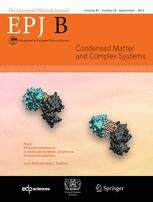Studying the motion of electrons in a disordered environment is no simple task. Often, understanding such effects requires a quantum simulator designed to expose them in a different physical setup.
This was precisely the approach adopted by Denis Makarov and Leonid Kon'kov from the Victor I. Il'ichev Pacific Oceanological Institute in Vladivostok in a new study published in EPJ B. They relied on a simulator of electronic motion subjected to noise stemming from a flux of sound waves.
Their findings could lead to semi-conductor devices of a new kind, operated through acoustic radiations. Through numerical simulation, the authors found that noise fluctuations lead to counter-intuitive electron transport behaviour and a change of direction in atomic transport.
They deducted that being exposed to sound wave fluctuation gives rise to an electronic current that spontaneously changes its direction.
More information: Makarov, D. V. and Kon'kov, L. E. (2014). Quantum transport in a driven disordered potential: onset of directed current and noise-induced current reversal. European Physical Journal B. DOI: 10.1140/epjb/e2014-50568-3
Journal information: European Physical Journal B
Provided by Springer






















